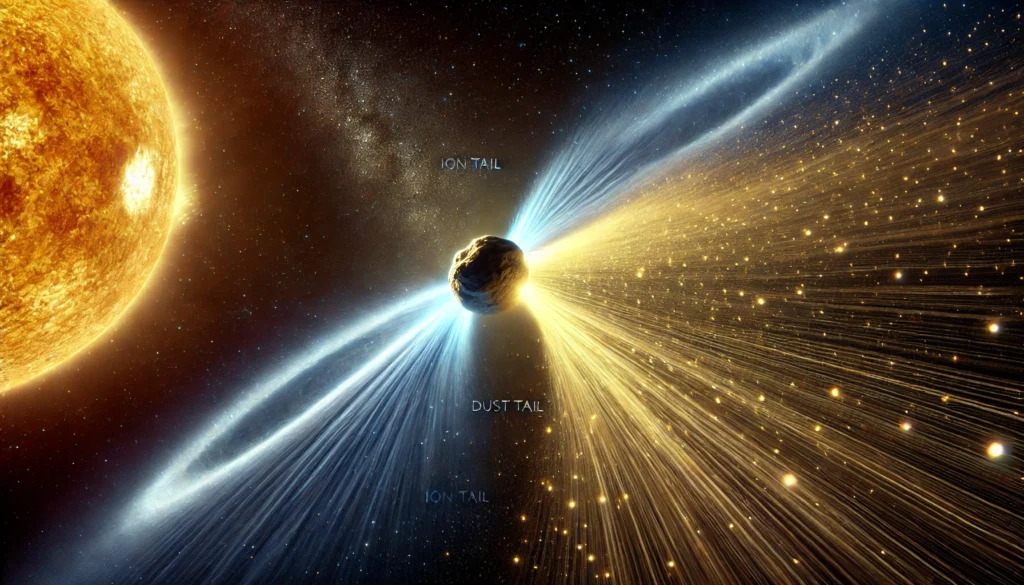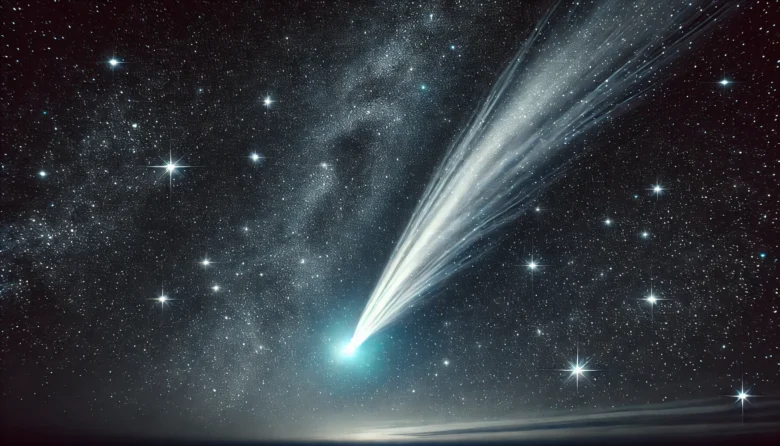Have you ever looked up at the night sky and caught a glimpse of a bright streak with a glowing tail? That mesmerizing sight is a comet, one of the most fascinating objects in our solar system. Comets have been subjects of awe and mystery for centuries, often linked to folklore and predictions. But what exactly are these celestial wanderers made of, and what gives them those stunning tails? In this blog, we’ll dive into the chemistry of comets and their tails, exploring the fascinating processes that turn these icy bodies into some of the most beautiful spectacles in the sky.
What Exactly Is a Comet?
Before we get into the chemistry, let’s first understand what a comet is. Comets are frequently referred to as “dirty snowballs” because they consist of a mixture of ice, dust, and rocky fragments. They originate from the outer regions of the solar system, specifically the Kuiper Belt and the Oort Cloud. These regions are packed with countless icy bodies that occasionally get nudged out of their stable orbits, sending them on a journey toward the inner solar system.
As a comet moves closer to the Sun, it begins to warm up, and this is where the magic—or rather, the chemistry—begins.
The Nucleus: A Frozen Time Capsule
The core of a comet, known as the nucleus, is a solid chunk that typically ranges from a few hundred meters to tens of kilometers across. The nucleus contains water ice, along with frozen gases like carbon dioxide (CO2), carbon monoxide (CO), methane (CH4), ammonia (NH3), and a mix of silicate minerals and organic compounds.
Imagine the nucleus as a frozen time capsule. The materials in the nucleus are thought to be remnants from the early solar system, over 4.6 billion years old. This makes comets incredibly valuable for scientists trying to understand the conditions that existed when our solar system was forming.

The Coma: A Glowing Halo
As the comet nears the Sun, the rising temperature causes the ice in the nucleus to transition from solid to gas, forming a surrounding cloud of gas and dust called the coma. The coma can be enormous, stretching thousands of kilometers in diameter, much larger than the nucleus itself.
The coma is made up of water vapor (H2O), carbon dioxide (CO2), carbon monoxide (CO), and other gases, along with dust particles. The sunlight interacting with these gases causes them to glow, giving the comet its characteristic bright appearance. The chemistry here is a mix of simple molecules like H2O and more complex organic compounds, some of which are crucial to the origins of life.
The Tail: A Tale of Two Tails
One of the most prominent aspects of a comet is its tail—or, to be more precise, its tails. Comets usually have two distinct tails: a gas (ion) tail and a dust tail. Both tails are formed by different processes but originate from the same source, the coma.
The Ion Tail:
The ion tail develops when the solar wind, a stream of charged particles released by the Sun, interacts with the gases within the coma. The solar wind ionizes (strips electrons from) these gases, creating charged particles (ions). These ions are then pushed away from the comet by the solar wind, creating a tail that consistently points away from the Sun. The ion tail often glows with a bluish hue thanks to the ionized gases, primarily carbon monoxide (CO+) and carbon dioxide (CO2+).
The Dust Tail:
The dust tail, on the other hand, is formed by the pressure of sunlight pushing dust particles away from the coma. Unlike the ion tail, the dust tail is usually curved and can appear white or yellowish due to the scattering of sunlight by the dust particles. This tail is made up of tiny grains of silicate and carbonaceous material, and it can stretch millions of kilometers into space.
Chemistry in Action: Case Studies of Famous Comets
To better understand the chemistry of comets, let’s look at two famous comets: Halley’s Comet and Comet NEOWISE.
Halley’s Comet:
Halley’s Comet is perhaps the most well-known comet, visible from Earth every 75-76 years. When Halley’s Comet last passed by Earth in 1986, it was studied extensively by spacecraft like Giotto and Vega. These missions revealed that the comet’s nucleus is rich in water ice, carbon dioxide, and organic compounds like formaldehyde (H2CO) and methanol (CH3OH). These findings supported the idea that comets could have delivered essential organic materials to early Earth, possibly aiding in the development of life.
Comet NEOWISE:
Comet NEOWISE made headlines in 2020 as one of the brightest comets visible from Earth in recent years. Observations revealed that NEOWISE had a particularly long dust tail and a well-defined ion tail, both of which provided insights into its chemical composition. The dust tail was found to contain silicate minerals, while the ion tail was composed of carbon monoxide and other ionized gases. This comet’s composition was similar to other long-period comets, reinforcing our understanding of comet chemistry.
Why Should We Care About Comet Chemistry?
At this point, you might be wondering why the chemistry of comets matters. Well, comets are more than just beautiful objects in the night sky; they are cosmic messengers carrying information about the early solar system. By studying the chemistry of comets, scientists can gain insights into the formation of our solar system, the origins of water on Earth, and even the building blocks of life.
Moreover, comets have practical implications for space exploration. For instance, understanding the composition of cometary material is crucial for future missions that might attempt to mine these bodies for resources, such as water or metals. Cometary chemistry also helps in planning spacecraft trajectories, as the outgassing of material from the comet can alter its path.
Conclusion
Comets are like time travelers from the early solar system, offering us a glimpse into a bygone era when our planet was just forming. The chemistry of comets and their tails not only adds to the wonder of these celestial bodies but also provides critical information about our origins. So, the next time you spot a comet in the sky, remember that you’re witnessing a cosmic chemical laboratory in action—one that has been operating for billions of years.
Author’s Note
Thank you for joining me on this journey through the chemistry of comets and their tails. If you’ve ever wondered what these celestial wonders are made of, I hope this blog has sparked your curiosity and provided some fascinating insights. Keep looking up, and you might catch a glimpse of the next comet making its way across the sky!
G.C., Ecosociosphere contributor.





Comments
What i do not understood is in truth how you are not actually a lot more smartlyliked than you may be now You are very intelligent You realize therefore significantly in the case of this topic produced me individually imagine it from numerous numerous angles Its like men and women dont seem to be fascinated until it is one thing to do with Woman gaga Your own stuffs nice All the time care for it up
Thank you I have just been searching for information approximately this topic for a while and yours is the best I have found out so far However what in regards to the bottom line Are you certain concerning the supply
I was just as enthralled by your work as you were. Your sketch is elegant, and your written content is sophisticated. However, you seem concerned about potentially delivering something questionable soon. I’m confident you’ll resolve this issue quickly and return to your usual high standards.
Sportsurge You’re so awesome! I don’t believe I have read a single thing like that before. So great to find someone with some original thoughts on this topic. Really.. thank you for starting this up. This website is something that is needed on the internet, someone with a little originality!